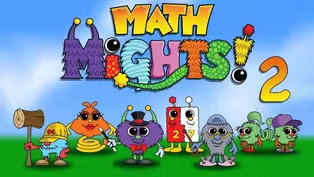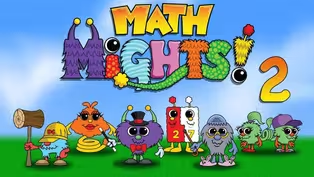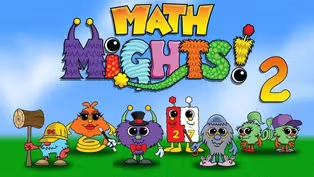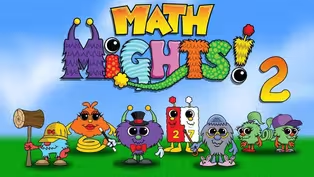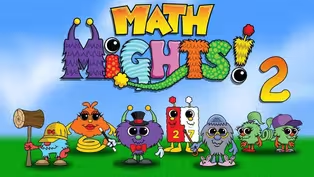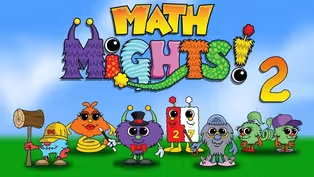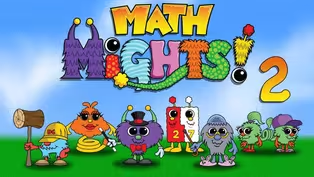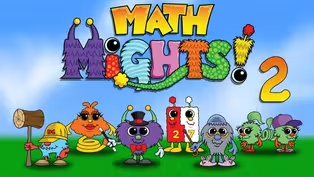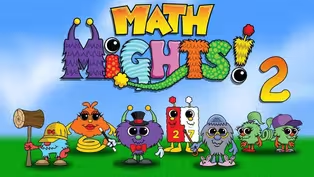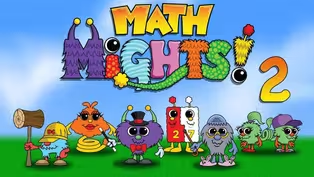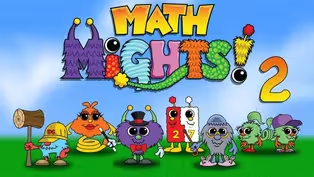Math Mights
Sort and Name Shapes
Season 3 Episode 307 | 15m 59sVideo has Closed Captions
Join Mrs. McCartney for some fun with Professor Barble doing a tricky comparison.
Join Mrs. McCartney for some fun with Professor Barble doing a tricky comparison word problem. Next we are going to explore triangles, quadrilaterals, pentagons, hexagons by sorting and naming a variety of shapes.
Problems playing video? | Closed Captioning Feedback
Problems playing video? | Closed Captioning Feedback
Math Mights is a local public television program presented by Detroit PBS
Math Mights
Sort and Name Shapes
Season 3 Episode 307 | 15m 59sVideo has Closed Captions
Join Mrs. McCartney for some fun with Professor Barble doing a tricky comparison word problem. Next we are going to explore triangles, quadrilaterals, pentagons, hexagons by sorting and naming a variety of shapes.
Problems playing video? | Closed Captioning Feedback
How to Watch Math Mights
Math Mights is available to stream on pbs.org and the free PBS App, available on iPhone, Apple TV, Android TV, Android smartphones, Amazon Fire TV, Amazon Fire Tablet, Roku, Samsung Smart TV, and Vizio.
Providing Support for PBS.org
Learn Moreabout PBS online sponsorshipMore from This Collection
"Math Mights" lessons for 2nd Grade students.
Video has Closed Captions
Join Mrs. McCartney for some fun with Professor Barble. (15m 59s)
Video has Closed Captions
Join Mrs. McCartney for some fun with Professor Barble. (15m 59s)
Video has Closed Captions
Join Mrs. McCartney for a word problem with Professor Barble that will make more sense. (15m 58s)
Video has Closed Captions
Join Mrs. McCartney for a comparison word problem with her friend Professor Barble. (15m 59s)
Compare 3-Digit Numbers Part 2
Video has Closed Captions
Join Mrs. McCartney to learn how to do a comparison word problem with Professor Barble! (15m 59s)
Comparing Numbers on a Number line
Video has Closed Captions
Join Mrs McCartney for a word problem with Professor Barble using Visula Models! (15m 59s)
Compare 3-Digit Numbers Part 1
Video has Closed Captions
Join Mrs. McCartney to see if we can figure out Professor Barble's comparison. (15m 59s)
Numbers represented in different ways
Video has Closed Captions
Representing numbers in different ways to show off your learning with place value. (15m 59s)
Video has Closed Captions
Put numbers together and taking them apart with expanded form. (15m 59s)
Video has Closed Captions
Join Mrs, McCartney for a Number Talk with her friend Springling! (15m 59s)
Video has Closed Captions
Join Mrs, McCartney for a Number Talk with her friend Springling! (16m)
Subtraction with 2-Digit Numbers Part 2
Video has Closed Captions
Join Mrs. McCartney for an addition number talk with D.C.! (16m)
Providing Support for PBS.org
Learn Moreabout PBS online sponsorship(bouncy music) - [Students] Math Mights.
- Welcome back second grade Math Mights my name is Mrs. McCartney.
I'm so excited that you've joined us today for some math fun.
Today, we're gonna start off with doing a word problem with my friend Professor Barble and then we're gonna be moving into geometry doing sorting and naming shapes.
Let's start off first with warming up our brain with my friend Professor Barble.
Professor Barble loves to do visual models.
Visual models are known as a model drawing, a unit bar, a tape diagram, or even a bar model.
A lot of kids love using this to help them visualize what the word problem is asking and in fact, it's a reading comprehension strategy.
Hey Professor Barble can you help us with our word problem?
Professor Barble is a Math Might that lives in Mathville and he loves to help students with word problems.
He likes to help you to slow down and not guess if you should add or subtract with word problems.
In fact, if he pushes on his cap, outcomes a starting line to help us to really create the visual model.
Let's see what problem we're gonna try to conquer for today.
My friend Rhianna and Lynette have a word problem that we wanna see if you can help us with.
Susan has 37 pennies.
Blake has 55 more pennies than Susan.
How many pennies does Blake have?
Our friend Rhianna says, "Maybe we should add?"
Lynette says, "Wait or should we subtract?"
Are you doing that?
Are you already guessing if we should add or subtract with this word problem?
We definitely need Professor Barble's help because we need to go through these steps to help us to understand first what the word problem is asking.
As we start to look at these steps we're gonna go through them together.
We're gonna read through the entire problem and put in a chunk.
You're in second grade so you can read right along with me.
Susan has 37 pennies.
Chunk.
We're chunking that information 'cause I just heard some new math information in that word problem.
Blake has 55 more pennies than Susan.
Chunk.
How many pennies does Blake have?
Chunk.
We have three chunks which means we have three pieces of information that we should add on to our visual model.
Step two is to put it into sentence form.
Blake has pennies.
Step three is to get that starting line ready because we need to put in our who and our what.
So as we look at our word problem on my board I already have the who or the what.
The who is Susan and Blake and these are the pennies.
This line here is the starting line that comes out of Professor Barble's hat that you just saw to help us slow down and visualize.
Step four is to draw in the unit bars.
Because this is a comparison bar, you can see that I've already put a bar in for both Susan and Blake.
There's no quantities in here it just represents their pennies.
Step five is the hardest for our second graders to learn because you have to go back in the problem and figure out the information that we're going to add on to our word problem.
So let's take that first sentence and look it says, "Susan has 37 pennies."
I'm gonna take Susan's bar and go ahead and label her 37 pennies 'cause that's what we read in the story problem.
You always wanna make sure you put that check-in to know that that information is ready to go.
Blake has 55 more pennies than Susan.
Let's take a look at Blake's bar we're going to add on 55 more.
It should even be a longer bar than I have room for because we know 55 is larger than 37.
We've added that information in so I'm gonna go ahead and put in the check.
The question mark wants to know how many pennies does Blake have.
So at the end of my unit bar I'm gonna put the question mark.
Now don't be fooled because original they both had the same amount but Blake had more.
So we have to think about how we're gonna do that.
Let's check off that statement that we already have our question mark in there because we know when we get to step six it's to correctly compute the problem.
What you're trying to figure out now looking at this do I have to add or subtract?
Our friends, Rhianna says, "Slowing down really helped me.
"Thanks Professor Barble."
Because now you have a good visualization of what the word problem is asking.
Lynette says, "Oh wow I did not understand the word problem at first "but that visual model really helped."
So let's take a look at how we're going to compute this.
If I know that 37 is gonna be the same size here as this box, I know to get the total for Blake's that I need to add together 55 plus that 37, you guessed it.
Mrs. McCartney loves DC so I'm gonna use DC's strategy but this is not the most important part of the word problem you can choose any strategy that works for you.
I'm gonna go ahead and decompose 37 into 5 because I know I want this to be the next decade number which is 60.
If I take the 5 out of the 37, I'm left with 32.
When I compose and put this together I now have 60 plus 32 and in a snap I know that that is 92.
Now that we've correctly computed the problem step seven is to go back and put in our answer into our sentence form.
It reads Blake has 92 pennies.
Boys and girls you did such a great job helping me solve that problem with Professor Barble.
Doing comparison problems can be really hard at first but using this process will help you each and every time.
Let's check out our I CAN statement for today.
I can sort and name shapes based on their sides and their corners.
Let's take a look at these two pictures, what do you notice?
What do you wonder?
Our friend Rhianna says, "I noticed that all the triangles are together.
"The other shapes are not triangles."
Let's take a look.
As we look at this here, I can see that all of these shapes on the left are triangles, but she's correct.
Over here nothing is triangles.
Lynette says, "Some of the shapes are shaded "and some look like pattern blocks."
I do see some that are shaded in blue and then a couple of these do look like some pattern blocks that I am familiar with.
Great noticing girls.
What are some wonders that our friends might have?
What are you wondering as you look at these two sets of shapes?
Rhianna says, "Why are some of the shapes shaded?"
Lynette that says, "What are the shapes with the 5 sides called?"
These are great wonders that we're gonna talk a lot about today as we discover shapes.
Let's take a look at those two pictures again that you were seeing.
I want you to answer this question, what can we name each of the groups?
So over here we have triangles and we could call these non triangles.
The reason for that is we have three corners and three sides.
That's a characteristic of all of these that you see here because they're all triangles.
When we look over here at these shapes, you can tell that they have more or less corners or sides so they won't be in the category of triangles.
We could call those non triangles.
We're gonna be doing more of that today.
I want you to think about putting a magnifying glass on to really start to look at shapes and look at their attributes.
What are the characteristics that we see when we're looking at shapes?
Take a look at all of these shapes that I have.
(indistinct) I gave these to you and ask you to sort them in categories in a way that makes sense to you.
Would you be able to explain your thinking and to be able to point out the attributes or the characteristics of the shapes that you're sorting by?
Let's see what our friend Rhianna says.
Rihanna said, "You could sort by shaded or non shaded."
Let's take a look at what I have here.
If I took all these shapes I could sort them by looking at the one that is shaded or not shaded.
So we have two different piles for this.
If I wanted to, I could sort them by big shapes or even small shapes.
So obviously I looked at these shapes here these look a lot smaller where these shapes here are a lot larger.
So in this way we can look at it by the color or even by the size.
Let's see what Lynette says.
She says, "We could sort them by sides or corners "because some have 3, 4, 5 or 6 corners or sides."
Let's see if we can do that.
I have sorted the shapes per Rhianna's suggestion.
Let's take a look at the shapes in our first row.
How many sides and how many corners do they have?
Here we can see that we have three corners and three sides.
I'm gonna go ahead and label these as a three.
Our next row we can count and see that each of these has four.
Not all of them are just a regular square you can have other shapes that have four sides and four corners that look differently.
So we're gonna categorize those as four corners and four sides.
Looking here I have shapes some of that you may have seen before but these all have five corners and five sides.
Down here there's some interesting different shapes that you can see all drawn in different ways but each of them has six corners and six sides.
We now have all of those shapes sorted by the number of sides and the number of corners.
Let's see now if we could name those shapes.
Let's take a look at this top row that we see here.
In the picture that you see a triangle has three sides and three corners.
Most second graders think that that's just what a triangle looks like but let's look at all of these they don't look like this exact perfect triangle there is sides with different lengths.
They all have three sides and they all have three corners.
So we can label all of these triangles a large variety.
As we start to look at the next row these all have four sides and four corners.
When you look at this picture you might just be seeing a square.
In second grade, we've always known a square to have four sides and four corners.
Our name for that is going to be a quadrilateral.
If we look at each of these pictures they do have four sides and four corners but they all don't look like a perfect square.
If it has four sides and four corners then we can identify that as a quadrilateral.
As we look at our next row these all have five sides and five corners.
The name for a shape like that is a pentagon.
You might actually recognize the pentagon like you see in the picture with the five sides and the five corners.
But did you know that all of these are also pentagons because they have five sides and five corners.
Our last row here shows that we have six sides and six corners in all of the pictures.
You're more familiar with this shape which has six sides and six corners and we call it a hexagon.
You've seen that hexagon before with pattern blocks but all of these are also hexagons because they have six sides and six corners.
Now that we have all of those shapes sorted by their corners and their sides and now we have an appropriate name for them, we're gonna play a game that's called penta-what?
You have to guess the shape that I have by asking yes or no questions to see if you can figure out based on the characteristics which shape is my secret shape.
Let's see if my friend Rhianna and Lynette can be the person that I'm playing with.
Let's see what their questions are.
Rhianna wants to know is your shape of a pentagon?
Nope, my shape is not a pentagon.
Now remember you wanna try to eliminate some of those things 'cause a pentagon we said had five sides and five corners.
Let's see what Lynette asks.
Lynette asks, "Does your shape have 6 sides and 6 corners?"
Well, I have my secret shape right here in front of me and in fact it does have six corners and six sides.
Can you guess the shape that I am holding.
Our friend Rhianna says, "I think I know what your shape is.
"I think it's a hexagon."
Watch for the reveal to see what I have.
Yup, she is right.
I am hiding the hexagon.
Playing a game like this will really help you to describe the attributes and listen to the clues that your friends are asking you to see if they can figure out what shape that you have.
Do you think that we can always put shapes into these categories?
Look at these three shapes that are drawn there.
Would these shapes belong in any of these categories?
Let's take a look at the first shape.
If I were to count the corners we have one, two, three, four and for the lines I have one, two, three, four, five.
I wonder what you're thinking about when you think of that shape.
Is it a shape?
A shape has to be closed and that one isn't and it definitely doesn't match the four shapes that we're working on today because it has one, two, three, four corners and one, two, three, four, five sides.
So this one definitely does not match.
Let's take a look at the middle shape.
It has one, two, three, four, five, six sides and one, two, three, four corners.
That didn't match the description of the four shapes that we're looking at.
Let's look at our last shape.
I see one, two, three, four, five sides and one, two, three corners.
None of these match the shapes that we were talking about today.
We wanna make sure that you understand the characteristics of a triangle, a hexagon, a pentagon, and a quadrilateral.
Now it's your turn to match shapes up with their names that we talked about today.
I've had so much fun hanging out with you today.
I sure hope that you join us next time.
(bouncy music) (high intensity music) - [Narrator 1] Sis4teachers.org.
- [Narrator 2] Changing the way you think about math.
- [Narrator 3] This program is made possible with funding from the Michigan Department of Education, Governor's Education Emergency Funds, the State of Michigan, and by viewers like you.
(bouncy music)


- Home and How To

Hit the road in a classic car for a tour through Great Britain with two antiques experts.












Support for PBS provided by:
Math Mights is a local public television program presented by Detroit PBS
